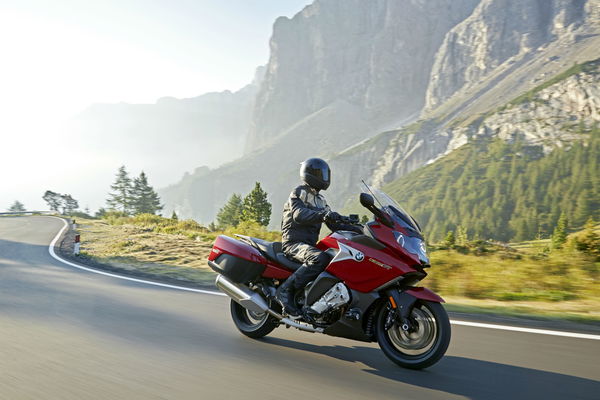First ride: Triumph 765 Street Triple RS review
Big-bike grunt and power. Still every bit a Street.
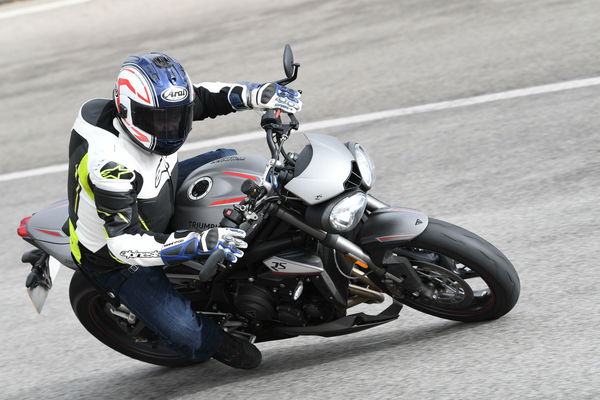
BARCELONA’S a fashionable, modern city, with a stack of heritage behind it, a booming economy – and a MotoGP circuit out the back.
Where better, then, for Triumph to launch its new 765 Street Triple? A bike (and a company) with impressive history, which is sailing high in the sales charts – and has a MotoGP link lingering about in the background...
We're here for a lightning day out with Triumph's new naked sporty-roadster. Half a day on the Catalan mountain roads behind Barca, then a half-day supersaver trackday ticket for Circuit de Barcelona-Catalunya. And we're riding the top-spec RS version of the 2017 Street Triple: the new 765cc, high-tech triple that aims to redefine the class – using an engine that's set to power the next generation of Moto2 race bikes after 2018.

Triumph's clearly proud of its new baby, and on paper at least, that looks pretty well-founded. A super-grunty new lump, ride-by-wire fuel injection, updated frame and swingarm, top-spec chassis jewellery and a slew of electronic aids – all present and correct, and ready to build on the base of an already strong bike. Legend has it that Triumph boss John Bloor's (possibly apocryphal) design brief for the last big Speed Triple update was "Don't f*** it up." They didn't with the Speed – have they with the Street?
It's hard to tell at first. We set out from the hotel on a cool, damp, eight-degree Spanish morning. There's mist draped over the hills, the roads are slick with moisture and the odd muddy trail from a dirt track entrance. That wouldn't have been such a problem if we hadn't been riding the RS, with its flash Pirelli Supercorsa SP tyres. A fabulous rubber option on a hot dry trackday – but they're not working well this morning, and we'd have been better off with a more road-biased tyre.
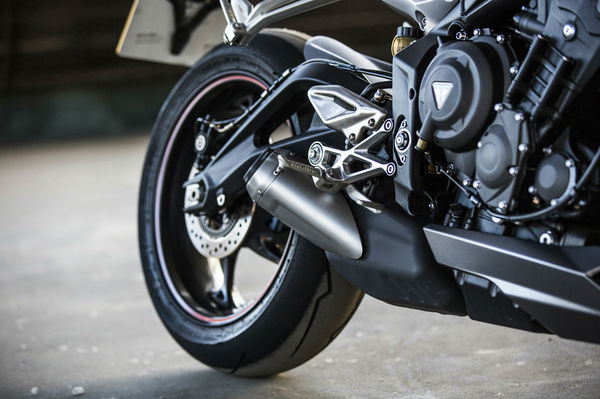
The rest of the bike is far more encouraging. The engine is the focus of much of my attention, and the signs are excellent. It feels more like a big-bike motor, closer to the Speed Triple than the old Street. Not that surprising of course – a 2017 765cc triple is probably approaching something like a 2010 GSX-R750 in terms of output. In fact, the Triumph is about 10hp down at the top end, but has the same peak torque figure as the Suzuki inline-four, in a lighter chassis.
That extra grunt over a 600-class machine is telling when we get off the mountain backroads and onto some faster, more sweeping roads. Give the new ride-by-wire throttle a big handful in second gear, and you can lift the front wheel with ease, even at motorway speeds – a trick that's far harder with a less beefy motor.
Stuntery aside, the fuelling is crisp and clean, albeit occasionally abrupt in the top-power 'Track' mode round town. The noise is fabulous though – Triumph's clearly worked out the trick of making a stonking aural noise bubble round the rider's head, yet managing to pass strict noise regs. The intake roar is hard-edged, raw, and super-satisfying. Combine it with the quickshifter that's standard on the RS (and optional on the S and R), and you have the ingredients for a brilliantly beguiling riding soundtrack.
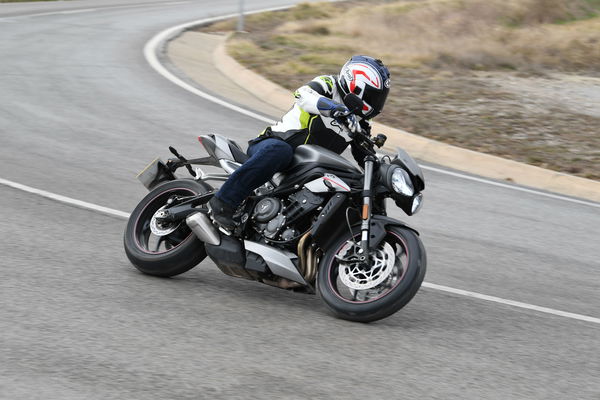
After the engine, the electronics are next to grab my attention. We had a brief explanatory run-through outside the hotel, but it takes a while for the basics to seep into your brain. At the heart of it is the new colour LCD dash, which is an excellent, top-notch set-up (it comes on the RS and R; you get a more basic monochrome screen on the S). Combined with new switchgear that includes a wee joystick, you can quickly scroll through options and settings – ABS and traction can be turned on or off, you can make your own custom riding mode on the R and RS, and there are Rain, Road, Sport and Track modes pre-set for you too. It's a level below the top-spec superbikes: there's no IMU inertial measurement unit to give the ECU info on lean angle, pitch and yaw. But you have more control than some set-ups; turning the ABS off completely isn't an option on several higher-end machines.

There's a tiny bit of nannying going on: you can't turn off TC or ABS while on the move, and if you do turn them off, they re-set every time you switch the bike off. That's a wee shame – if you want TC on the twisties and big wheelies on the straights, you’re going to have to stop in between.
But I'm comfortable with no traction at the moment: the temperature gauge on my colour dash is now reading 12 degrees, the roads are drying out, and the Supercorsas are warming up nicely. I've left the ABS on though: the Brembo M50 calipers up front are mighty sharp and powerful, and while I'm not really fazed by them, I'm grateful for the safety net of the ABS when I run in a little hard on some patchy, damp, shadowy bends.

The Street steers quickly enough, but with loads of precision and stability too. The chassis engineer tells us later that the more powerful engine meant they needed to relax the steering geometry a little to increase the bike's fundamental stability. And indeed, there's no flapping from the front, even with the sporty rubber and no steering damper. It just feels the way you'd want a really sorted, responsive naked roadster chassis to be. The suspension is spot-on too; the RS comes with Showa Big Piston forks and an Öhlins single tube rear monoshock, which is pretty much the top drawer for this class of bike. The wheel control is excellent with the standard settings, and there's plenty of fettling options for you to dial in your favoured behaviours, on road or track.
And we've arrived at the track now. I'm keener than usual to get on – the forecast said rain by 4pm, and the clouds are looking rather threatening. The Triumph guys are on the ball though – they swap round the lunchtime tech presentation so we can get on track straight off, after the marshals have had their lunch.
Catalunya's an enormous track – a big, bold, ballsy place, in the mould of Mugello or Silverstone. It could easily swamp a small bike – something like a Honda Hornet 600 would feel like a minimoto round this wide, open, long circuit. I've been here before a few times, but not for a decade at least, so my memories are a little dim. Fortunately, we’re led round by TT racer Gary Johnson for the first couple of laps. Unfortunately (for me), Gary's idea of a 'steady' sighting lap or two is a few notches up from most folks’, and I'm soon frantically thrashing away to keep up with him…
Thankfully, Triumph packed tyre warmers, so the Pirellis are ready for big lean straight away. The whole bike is ready actually – I instantly feel right at home on the Street here. That engine is more than up to the surroundings, with a fab mix of low-down drive out of the slower corners, and screaming top-end pull down the massive main straight. I'm literally struggling to hold on at top speed – there's nowhere to hide on the small naked roadster, and I'd have paid good money for some sort of little flyscreen to help deflect the windblast.

The chassis is just as capable. Them Brembos are now in their element, hauling me down from top speed with power and grace, and packed with the feel needed to get on them hard. Round the big, fast sweeping turns three and four, it's super-stable, and you can place yourself right where you want to be. Getting on the power out of the tighter turns is also a real pleasure – the Street just digs in, grips and goes. That's helped by a 4mm higher swingarm pivot, we later learn from the chassis engineers. Moving that up improves the bike's behaviour under power, giving better grip as the suspension loads up and the back squats down.
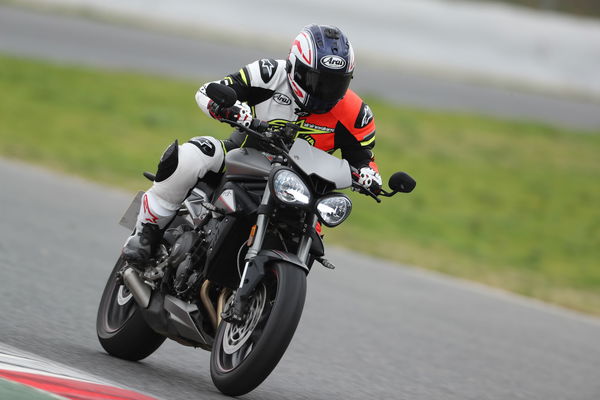
The first session is over, and I'm ready for a wee sit-down. The combination of wide-open track and windy conditions, with that super-strong motor and zero wind protection, means I'm fried from just holding onto the thing. I'm happy though: the little Triumph has been just brilliant on track, and is packed with potential. A couple of bottles of salty local agua con gas, and I'm ready for another go.
But the gods aren’t smiling on us. As we pull out of pit lane, big, fat angry drops of rain land on my black Arai visor, and keep falling. Now, I'll quite often stick with a track launch when it rains. If you can get some race wets fitted, or even just a decent sport-touring road tyre, you can learn a lot about a bike on a wet track. But the conditions quickly turn terrible here. The Catalan asphalt is designed to cope more with 50-degree summer track temperatures than wet, eight-degree conditions, and the grip levels plummet. The Supercorsa tyres are also returning to their sullen state from this morning, and within half a lap, there's absolutely no control at all. I'm using the 'Track' mode, which turns off the rear ABS – but the back wheel is locking when I change down a couple of gears, never mind using the brake. The front ABS is still on, but even it's really struggling now. An air of disbelief transmits itself through the brake lever to me, as the ABS pump cycles on and off, unable to apply more than a hint of stopping power before the wheel starts to lock.

The final straw comes when I'm heading down to turn four and try to slow down and turn in. The back locks up, and the front wheel cycles lazily from locking to releasing, as I frantically pray to the gravel-trap gods…
I stay upright, and finally wobble round the bend. I look round, and Supersport racer Luke Stapleford is right behind me, laughing his head off inside his lid. Enough…
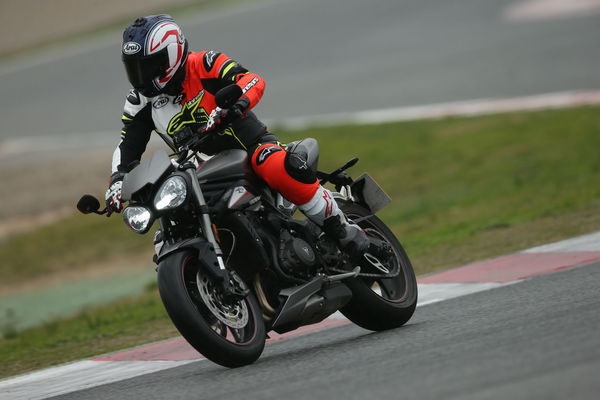
Back to the pits, and it's time to ride back to the hotel. I throw on all the waterproofs I've brought ready for the monsoon conditions, and we set off home. Thoughtfully, the Triumph techs have fitted brand-new Supercorsas for us, but we stick to the motorway and are back to base quickly and efficiently, if totally drenched.
Time for a beer and a ponder on the new bike then. It's fair to say that I'm quite impressed with the 765 Street. Triumph's kept much of the character and styling of the old bike, but has cranked up the good stuff at the same time. The engine is a corker, and I can't wait to see what it's like in a Moto2 chassis. It has the potential to become a modern 'GSX-R750' option: a lighter, more precise choice compared with the 220hp litre blasters of this world, yet far stronger and gruntier than a conventional 600 supersports class bike. The new Street's chassis is an excellent match for the engine too – with great inherent handling, plus top-level running gear. And finally, the electronics have been well-executed, giving enough control to the rider to dial in what they want, and still providing the safety nets that modern bikes want to give. All this – and it's well priced too! Under £10k for this top-spec RS version is impressive stuff, and with the basic S coming in at £2k less, Triumph's played a blinder.
Criticisms? I'd have liked to see an auto-blipping downshifter added in there (maybe as an option), plus the stuff like cruise control that ride-by-wire makes simple to implement. The nannying from the electronics is a bit of a faff too – it'd be better to have something like BMW's 'Master Key' option, where you can set less stringent parameters overall, if you're an experienced rider and happy with the risks.
This is small stuff though. The new Street Triple is a very good bike indeed, and if you're in the market for a sporty, well-appointed naked roadster, you really should give this one a test ride.

Model tested: Triumph 756 Street Triple RS
Price: £9,900 (RS), £8,900 (R), £8,000 (S)
Engine: 12v inline-triple, DOHC, liquid cooled, 765cc
Bore x stroke: 78x53.4mm
Compression ratio: 12.65:1
Power (claimed): 123hp@11,700rpm (RS) 118hp@12,000rpm (R) 113hp@11,250rpm (S)
Torque (claimed): 57ft lb@10,800rpm (RS), 57ft lb@9,400rpm (R), 54ft lb@9,100rpm
Transmission: six speed, slipper clutch, chain
Frame: aluminium twin spar
Front suspension: 41mm fully-adjustable Showa USD forks (S has SFF forks, R has SF-BPF, RS has BPF
Rear suspension: Showa shock (S and R), Ohlins STX40 shock (RS)
Brakes: Nissin twin-piston sliding calipers (S), Brembo M4.32 four-piston radial calipers (R), Brembo M50 four-piston radial calipers (RS) 310mm discs (front) 220mm disc, single-piston Brembo caliper (rear)
Wheels/tyres: cast alloy/Pirelli Diablo Rosso Corsa/Supercorsa (RS), 120/70 17 front, 180/55 17 rear
Rake/trail: 24.8°(S) 23.9° (R&RS)/104.3mm (S) 100mm (R&RS)
Wheelbase: 1,410mm
Dry weight (claimed): 166kg
Fuel capacity: 17.4 litres
